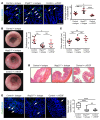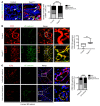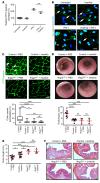IFN-γ drives inflammatory bowel disease pathogenesis through VE-cadherin-directed vascular barrier disruption
- PMID: 31566580
- PMCID: PMC6819119
- DOI: 10.1172/JCI124884
IFN-γ drives inflammatory bowel disease pathogenesis through VE-cadherin-directed vascular barrier disruption
Abstract
Inflammatory bowel disease (IBD) is a chronic inflammatory disorder with rising incidence. Diseased tissues are heavily vascularized. Surprisingly, the pathogenic impact of the vasculature in IBD and the underlying regulatory mechanisms remain largely unknown. IFN-γ is a major cytokine in IBD pathogenesis, but in the context of the disease, it is almost exclusively its immune-modulatory and epithelial cell-directed functions that have been considered. Recent studies by our group demonstrated that IFN-γ also exerts potent effects on blood vessels. Based on these considerations, we analyzed the vessel-directed pathogenic functions of IFN-γ and found that it drives IBD pathogenesis through vascular barrier disruption. Specifically, we show that inhibition of the IFN-γ response in vessels by endothelial-specific knockout of IFN-γ receptor 2 ameliorates experimentally induced colitis in mice. IFN-γ acts pathogenic by causing a breakdown of the vascular barrier through disruption of the adherens junction protein VE-cadherin. Notably, intestinal vascular barrier dysfunction was also confirmed in human IBD patients, supporting the clinical relevance of our findings. Treatment with imatinib restored VE-cadherin/adherens junctions, inhibited vascular permeability, and significantly reduced colonic inflammation in experimental colitis. Our findings inaugurate the pathogenic impact of IFN-γ-mediated intestinal vessel activation in IBD and open new avenues for vascular-directed treatment of this disease.
Keywords: Cytokines; Gastroenterology; Inflammatory bowel disease; Vascular Biology; endothelial cells.
Conflict of interest statement
Figures









References
-
- Ng SC, et al. Worldwide incidence and prevalence of inflammatory bowel disease in the 21st century: a systematic review of population-based studies. Lancet. 2018;390(10114):2769–2778. - PubMed
Publication types
MeSH terms
Substances
LinkOut - more resources
Full Text Sources
Other Literature Sources
Molecular Biology Databases

